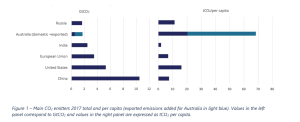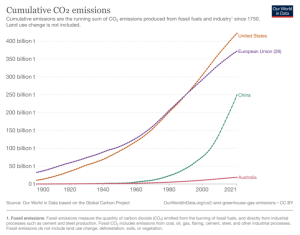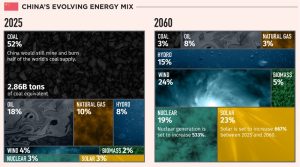If an AHA! moment happens on a delegation, does anybody hear it?
There’s an often-quoted philosophical question about the sound of a tree falling in a forest.
Does it only make a ‘sound’ only if someone is there to hear it?
No trees fell on us during our recent “Green Economy Discovery” delegation into Hong Kong and Mainland China last month, but there were plenty of aha moments.
An so I propose the philosophical challenge to ACBC members reading this article around the aha moments from the delegation. They happened, but will anybody hear them?
Green Economy Discovery delegation purpose.
I’ve been harping on about the opportunities for Australia from closer collaboration with China on the climate challenge for nearly 2 years. In my experience, this “Green Economy“ opportunity is often filtered into a climate science debate and confused with a COP conversation as opposed to wealth creation and prosperity.
The Wisdom of Youth
Another parable emphasises the wisdom of youth, “out of the mouths of babes”. And so it was that along the comments from the experienced China business veterans on the delegation (including HSBC, Telstra, Rio Tinto, FMG, Cochlear,) it was the brutal honesty of New Columbo Plan Scholarship winner and delegation intern Carol Lin that sets the scene for the biggest trees to fall. When asked to contribute to the delegation report being prepared for Australian Departments of Foreign Affairs and Trade, her unencumbered observations of the week of experiences for her were prescient as they were instructional.
“China has a huge challenge to decarbonise.”
“China doesn’t’ know what we [Australia] have to offer to help them with this.”, and
“Australian business doesn’t know what China needs from Australia.”
“China has a huge challenge to decarbonise.”
Australia, a country with ~26 million people and a GDP of ~A$2.2 trillion (US$1.3 trillion), generates the equivalent of around 500 million tonnes of CO2 (greenhouse gas) per annum (0.5GTCO2e). Not much when you compare to China (below), but at nearly 20 tonnes per person, we rank a close second to the US on a per capita emissions basis).
If you add to this Australia’s emissions from exports[1], well we really pop!
[1] https://climateanalytics.org/latest/australia-on-track-to-become-one-of-the-worlds-major-climate-polluters/
In June 2022, the Albanese government introduced a new target of reducing greenhouse gas emissions by 43% below 2005 levels by 2030. This new target is more ambitious than the previous target, but it is still not enough to meet the goals of the Paris Agreement and requires an estimated additional $200 billion and $300 billion!
China, with a population of ~1,400 million and a GDP of ~US$15 trillion, now generates a third of the world’s greenhouse gas emissions (~around 12 billion tonnes), and despite domestic policy changes is still projected to continue on its challenging emissions trajectory through to 2030[1].
Such is the scale and structure of China’s economy.
But this is changing on their legislated path to Net Zero by 2060, and this is Australia’s Green Economy opportunity.
According to the World Bank’s Country Climate & Development Report for China[2], investments of upwards of US$17 trillion will be required for an accelerated decarbonisation drive to reach peak emissions before 2030 and reduce cumulative carbon emissions to achieve Net Zero by 2060.
This investment will be needed in a variety of areas, including what China has already done in renewable energy and low-carbon transportation, but there is still so much to be done including in all of the downstream areas of urban renewal, rural rejuvenation and environmental remediation. Poles and wires are just the start [3].
China is an active participant in the global discussions on how to curb climate change, including the many financial market taxonomy dialogues[4] and the recent successful Kunming COP15 Dialogue on Biological Diversity[5].
The country’s latest five-year plan, (2021 through 2025), placed decarbonisation and the “construction of a green development engine” at the centre of policymaking.
Understanding more about this new “high quality growth” agenda was the purpose of the delegation. (AHA!1)
China will require a huge scale-up in green infrastructure and technology to achieve its aims of peak emissions by 2030 and carbon neutrality by 2060 and in recognition of the importance of China in determining the stabilization of the Earth’s climate many mitigation policies have been introduced. In 2007 China’s National Leading Committee on Climate Change and The National Climate Change Program were established, of which Australia originally was an advisor to. These introduced goals to reduce energy intensity and increase the share of non-fossil energy.
China’s Nationally Determined Contributions (INDCs) were set in 2015, then in September 2020, President Xi proposed a long-term mitigation goal of carbon neutrality before 2060 and enhanced INDC targets (to a >65% reduction in carbon intensity by 2030) in December.
“China doesn’t know what we (Australia) have to offer to help them with this.”
From the new Government in Hong Kong SAR to the heads of the Industrial and Technology Development Zones in Hong Kong and Shenzhen (the Greater Bay Area), the message was politely delivered, “we love Australia, but we don’t know what you have to offer us to help us get to where we’re going”. “You are welcome to come here and contribute”.
Again, from the boardroom advisors in Beijing, to the chiefs of Binhai’s dynamic Technology and Economic Development Zone in Tianjin[6], “we’re open to all comers to join us here and help with the transition, we just haven’t seen too many Australian companies participating”.
In her address to delegates in Beijing, the Secretary General of ACBC’s strategic MOU partner the Association of Green Economic Development Zones in China (GPIPC[7]) shared the KPI requirement for 30% of investment in China’s Economic Development Zones, responsible for 25% of China’s GDP, require 30% of investment to come from foreign capital.
China is open to foreign companies. 11 Provinces have established 81 International Cooperation Parks, with 6 more coming online in the last 12 months. None with Australia.
Australis’s trade and investment promotional activity is too heavily weighted towards historically favourable economic areas like Education and Agricultural products when it is our technical and procedural smarts and services that will be the winners.
A new Green Economy trade services promotion program is required.
“Australian business doesn’t know what China needs from Australia.”
With the forced hiatus from face-to-face interactions and the dented trust from trade policy derailments, Australian business has missed the memo on what China wants and indeed, on being able to showcase what Australia has to offer.
Yes, China has changed, but Australia is not educated about the real how.
And with the current political ‘stabilisation’ needs being met with no appetite for a reset, Australian business needs to reboot its idea of the opportunity that China presents and review its ‘national interests’ within the macro-economic paradigm of this new high-quality growth.
We need to unlearning old belief systems or we’re not going to compete with our neighbours in our region who are rapidly moving up the ladder of economic complexity[8].
With a GDP growth forecast to 2030 of 5.8% (3X that of Australia) and a focus on its domestic consumption, technological, energy and food independence, Australian businesses need to learn how to grow locally by investing overseas.
Every country in the region is managing China’s growth and the change this brings.
However, as opposed to Australia “Diversify from China” trade focus, the countries on our region have a ChinaPlus strategy.
- Ride on the growth of China to grow domestic (sovereign) capabilities (with China) and move up the ladder of economic complexity.
- Participate in the new Asia-focussed global supply chain trends.
- Develop productivity efficiencies and develop a defendable competitive advantage in key areas of the new Green Economy – energy, transport, advanced manufacturing, finance, food and the built environment.
Yes, education and tourism will grow as China (and ASEAN’s) economy grows.
But just what is Australia’s industrial area of advantage in this new Green Economy need to be worked on before the cliff of commodities trade arrives in the next decade.
The next steps
Whether the sound of the trees of AHA’s! falling in the forest of our delegation findings get heard will be up to you.
We will be tabling our findings from the delegation with key Ministers in June.
ACBC’s Green Channel will continue to facilitate Industry roundtables and dialogue around the new economic opportunities for Australia. Keep a look out for events in your region.
We will continue to work on facilitating collaborations on climate solutions in Australia and in China through our partnership with the Green Parks Association.
And we will be reaching out to key industry-sector partners to identify opportunities for sector-focussed in-market deep dive delegations into the China’s Green Economy opportunities.
Please reach out to discuss if you’re interested in participating in any of these initiatives.
Anthony Coles
Chair, ACBC Net Zero Working Group
anthony.coles@acbc.com.au
Refer to ACBC “Collaborations” Report
[1] https://climateactiontracker.org/countries/china/
[2] https://www.worldbank.org/en/country/china/publication/china-country-climate-and-development-report
[3] https://www.visualcapitalist.com/chinas-energy-transition-in-5-charts/




